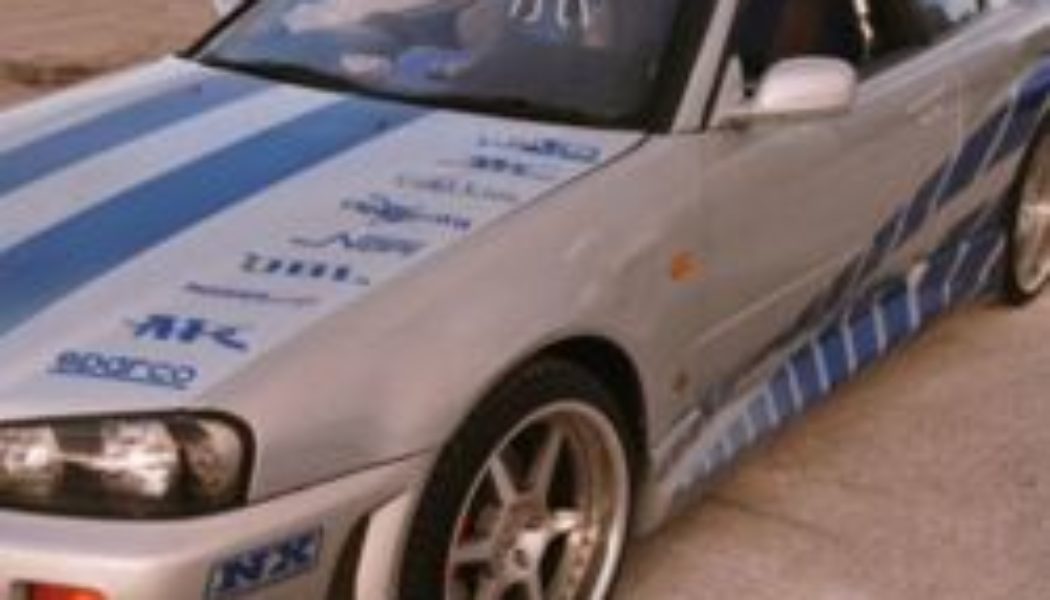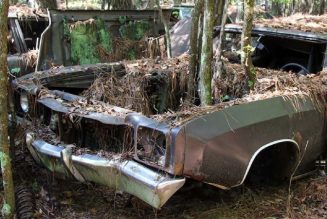Thereʼs always been something special about movie cars. From Steve McQueenʼs ʼ67 fastback Mustang in “Bullitt” to Burt Reynoldsʼ black Trans Am in “Smokey and the Bandit” to the GT500 Mustang Nick Cage called Eleanor in “Gone in 60 Seconds,” movie cars become objects of desire.
This is due to something called movie magic. Without movie magic, Steve McQueenʼs Mustang would have fallen apart after the first jump, Burtʼs smogger motor T/A would have been stopped at the first road block, and Eleanor would have ended up in the Long Beach impound.
Well, we decided to take a sledgehammer to movie magic and that sledgehammer is our trusty radar gun. We trucked six of the cars from “2 Fast 2 Furious,” the sequel to the 2001 summer blockbuster “The Fast and the Furious,” out to California Speedway in Fontana, California, for a day of testing. We wanted to see just how fast the movie cars really are.
To find out we ran each through our usual battery of tests, including skidpad, 60-to-0 braking and the all-important acceleration runs from 0-to-60 mph and through the quarter mile. For safety’s sake, we skipped the slalom test. Although most of the cars had four-point harnesses, we questioned the way they were mounted and didnʼt want to take any chances.
Of the hundreds of cars in the movie, we chose the six we thought were the most interesting. They are the Nissan Skyline GT-R, Toyota Supra Turbo, Mitsubishi EVO VII, Honda S2000, Mazda RX-7 and for kicks, we included the 427-cubic inch 1969 Chevrolet Camaro. Donʼt laugh. It turned out to be the quickest car of the day.
One more thing should be pointed out. We chose to test the most authentic version of each car. You need to realize that each car used in the movie has four or five doubles, with varying equipment and build quality. A good example of this is the 427 four-speed Camaro we tested, which was used for close-ups and some drive-by stuff. The production team also used several other cosmetically duplicate 1969 Camaros for stunts, but those had small-block 350-cubic inch crate motors and three-speed automatic transmissions.
So how fast are they really? Read on, and see for yourself. Just remember, movie magic has no place in Sport Compact Car. -Scott Oldham
1993 Toyota Supra Turbo: Old Dog, New Tricks
Considering the prominent role played by a Toyota Supra in the first “The Fast and the Furious,” itʼs somewhat curious to see one back in the series that isnʼt orange and isnʼt driven by either Paul Walker or Vin Diesel. The gold Supra in “2 Fast 2 Furious” is instead piloted by a character called Slap Jack played by actor Michael Ealy. Why heʼs called Slap or why heʼs called Jack hasnʼt been explained to us, but if heʼs doing much slapping or jacking, he ought to stop before he goes blind.
Unlike most of the cars in “2 Fast 2 Furious” that were close to stock mechanically, the Slap Jack ʼ93 Supra has been transmogrified with the replacement of its stock twin-sequential turbos with a GReddy single-turbo system. With a big GReddy T-88 turbocharger crushing the intake tract of the 3.0-liter, DOHC, straight-six, the potential for a stupid-fast Supra is obvious. In the “2 Fast 2 Furious” universe, transportation coordinator Ted Moser says this car comes packing 654 hp and a big chunk 525 lb-ft of torque, which is good enough, in that alternate reality, to thunder the Supra to 60 mph in just 4.5 seconds and through the quarter mile in just 11.9 seconds. In the real world, itʼs a different story.
Ladled on top of the Supra is a Versus Motorsports body kit and about an acre-foot of House of Kolor gold mine pearl paint. The 19-inch wheels are OZ SuperLeggeras and they’re inside a set of Toyo Proxes T1-S tires. The interior is overstuffed with electronics, including a Panasonic in-dash video system and a Rockford Fosgate amp so humongously huge that it pretty much fills the carʼs rear cargo area and rests on a panel that looks like machined aluminum between the roll cages down bars and next to dummy nitrous bottles.
The result is that rearward vision not blocked by the amp is wiped out by the tall rear wing. Hey, who needs to see whatʼs behind them anyhow? An interesting feature is a vented Plexiglas panel on the hood that leaves the engine visible for display, much like a Ferrari 360 Modena.
Showing 93,200 miles on its odometer, the Supra was a pretty beat used car long before it wound up in the hands of “2F2Fʼs” transportation department. And it drives like a beat-up Supra. “Straight ahead, the steering wheel is at 90 degrees,” explains Josh after his acceleration runs. “Iʼm not sure it would be safe in a straight line.” For a 10-year-old car that had had its structure ripped apart by 90,000-plus miles of commuting and creative abuse at the hands of a bunch of movie maniacs who thought of it as disposable, the Supraʼs structure was still impressively intact and the untouched six-speed shifted well. This car would work as pretty good raw material for anyone wanting to build a hero machine.
Though it makes a wicked howl when the turbo spools up, itʼs not making anywhere near 654 hp. This thoroughly beat drivetrain pushed the Supra down the real world quarter mile in a lackadaisical 14.5 seconds at 94.0 mph and made it from 0-to-60 mph in 6.4 seconds. Back in its first test of the ʼ93 Supra Turbo, Car and Driver ripped off a 13.1-second time in the quarter mile at 109 mph and ripped from 0 to 60 in just 4.6 seconds. Weʼve driven other GReddy-hyped Supras and know that if itʼs running right, it’ll run 12s even if your great-great-great-grandfather who had never even seen a car before was driving—and heʼs dead!
Feeling sloppy on the skidpad, the Supra could only manage to pull 0.90 g, despite the big wheels and tires. It did drift dramatically however and, really, thatʼs more important in the movie world than grip.
But that big turbo does produce plenty of heat. In fact, it makes so much heat, the cool-looking Plexiglas hood panel was melting into ever more bizarre shapes throughout our day of testing. But the malleable plastic was easy to resculpt into fun shapes. Sparco Torino seats and a Sparco steering wheel and new gauge pods are also aboard, with the pods holding appropriate Greddy gauges. When we last saw it, the panel sort of looked like a bunny rabbit drowning in a puddle of mercury.
1999 Nissan Skyline GT-R R34: Two-Wheel Drive, Not Too Fast
No car has quite the same reputation as Nissanʼs Skyline GT-R. Itʼs not officially sold in the United States, barely qualifies as compact, and is built with its steering wheel on the wrong side, but the all-wheel-drive, sequentially twin-turbocharged Skyline GT-R has managed to become a legend in America. That the producers of “2 Fast 2 Furious” recognized that is at least somewhat encouraging—isnʼt it?
The Skylines used during filming were all R34s, a model introduced in 1998. Like other Skylines, the R34 is powered by a RB26DETT 2.6-liter, DOHC, 24-valve straight six sitting longitudinally in the engine bay thatʼs force fed by twin turbos and rated at a laughingly low 280 hp. The R34ʼs engine feeds a six-speed Getrag gearbox that in turn sends power to the ATTESA all-wheel-drive system, which electronically varies the torque split.
Super HICAS four-wheel steering is also aboard and includes an electronic feedback control system to ensure precise wheel positioning under extreme circumstances. But the big change for the R34 from previous Skylines was a stiffened body shell and fresh aerodynamic design. This car has carbon-fiber under-car diffusers and a new rear wing.
In fact, the Skyline R34 is such an effective piece of technology, it was too good for movie work. All-wheel-drive supercars are quick and amazing to drive, but theyʼre absolutely nonchalant about their work. It takes a rear-quarter hit by an out-of-control Country Squire to get an R34ʼs tail to swing out dramatically, and burnouts are tough in a car with more traction than a Caterpillar D9. So the “2F2F” transportation department excised the front driveshaft and disabled the Skylineʼs four-wheel steering so it could misbehave like a regular car.
For its appearance on camera, the Skyline was encrusted within a C-West body kit, drenched in House of Kolorʼs platinum pearl paint and treated to a set of 19-inch HRE 446 polished wheels inside Toyo Proxes T1-S tires. Inside, the front passenger seat was ditched in favor of not one, not two, but three nitrous bottles—none of which are actually plumbed into the engine. Also thrown in is a Clarion head unit with LCD TV screen, a big JBL amp and Infinity speakers that actually seem to work. Of course, it also carries a bunch of blue neon and spits blue flame from its exhaust system.
As one of the two cars driven by too-pretty-for-a-guy hero Officer Brian OʼConner (played by the late Paul Walker), the Skyline, according to transportation coordinator Ted Moser, has 505 hp on tap and a hoarking 444 lb-ft of torque. In that “2F2F” alternate universe, that means this car rockets to 60 mph in just 4.1 seconds, consumes the quarter-mile in 12.1 seconds and has a top speed of 180 mph. Back on the actual planet Earth, the performance is still strong, but not quite as strong as fresher, intact R34s weʼve driven.
With Josh Jacquot doing his suave Paul Walker imitation, the Skyline, which is bone stock under the hood, groped its way through the quarter in 14.1 seconds at 101 mph—the third quickest car of the six included in this movie car test. With 22,254 km (13,797 miles) on its odometer, this car wasnʼt old, but it definitely had been beaten up pretty determinedly. Power output seemed down from other R34s, but a direct comparison is tough since the other R34s had the advantage of all-wheel-drive launches and didnʼt need a feathery throttle down the track. This car literally smoked its rear tires on every 1-2 upshift, which was cool to watch but certainly added time to each run. Its performance is also sabotaged by its big diameter wheels and the added heft of all the add-ons. The last stock R34 we drove hit 60 mph in just 5.07 seconds and crushed the quarter mile in 13.3 seconds at 103.7 mph.
The lack of AWD and 4WS knocked the movie Skylineʼs performance to 0.91 g on the skidpad, although we expected worse. The missing front differentials made the car much easier to drift, which is of course, the point, and we have to admit the car looked great doing it.
As for the brakes, they remain stock all around, and the ABS is intact. From 60 mph, this car stopped in 127 feet. Again, not a terrible performance, but not exactly what weʼve come to expect from a Skyline GT-R.
Overall, the Skyline turned out to be one of the better running and better sorted of the six cars. The driverʼs seat is a Sparco Milano and the additional gauges are HKS products. “Itʼs not too bad,” Josh reported after his quarter-mile runs. “Now we know how a rear-wheel-drive R34 performs.”
1995 Mazda RX-7: No Pulp
Just because there was an RX-7 in the first “The Fast and the Furious” doesnʼt mean the RX-7 in this second one is the same RX-7. With Vin Diesel opting out of the sequel, the RX-7 seat was opened up to a new character named “Orange Julius” because, we guess, he lives in Florida where they grow oranges and his name is Julius? Remembering the characterʼs name must have been easy for the actor tapped to play him, Amaury Nolasco, because itʼs plastered all over the car.
Naturally Orange Juliusʼ 1995 RX-7 is orange, in this case House of Kolorʼs ultra orange pearl. That paint goes over a Versus Motorsports body kit and envelopes a set of 18-inch Ro_Ja wheels inside Toyo T1-S Proxes tires. Inside, they’ve crammed in a set of Sparco Torino seats, added GReddy boost, EGT and temperature gauges and bolted in some APC fire extinguishers. Surprisingly, the sound system is stock. The steering wheel is a Sparco piece as well, with “N2O” labels at the trigger buttons coming from the incredibly handy Brother P-touch labeler. Since the Nitrous Express system isnʼt hooked up, pressing those buttons does little more than tell the audience that the system has been fictionally engaged.
In fact, the RX-7 that showed up in Fontana was mechanically stock. Power still came from Mazdaʼs sequentially turbocharged 13B twin rotor engine which, way back in ʼ95 was rated by Mazda at 255 hp. That engine feeds a five-speed manual transmission that in turn sends power back to the rear wheels. The suspension is all independent with double wishbones in the front and a multi-link system in the rear. The entire theory behind the third-generation RX-7 was to reduce mass and the car weighed less than 3,000 pounds.
With nearly 50,000 miles on its clock, this RX-7 lived a full life before being acquired by the “2F2F” transportation department, and it feels like a car thatʼs loosened with age. The engine hasnʼt been touched and somehow lived through filming without shattering into shrapnel. But the carʼs 14.6-second at 93.8 mph quarter-mile performance and 6.4-second 0-to-60 time indicate that itʼs definitely down on power. Stock third-gen RX-7s usually run either lower in the 14s or in the high 13s with 0-to-60 times in the low fives. In the fictional “2F2F” world, OJʼs RX-7 makes 350 hp, runs to 60 in 4.9 seconds and the quarter goes by in 13.6 seconds.
The car didnʼt do too well on the skidpad either. “This is the only RX-7 Iʼve ever driven that goes from understeer to oversteer and back to understeer with no provocation
whatsoever,” says Dave Coleman after a run around the circle. Does that mean thereʼs something bent, disconnected or missing in the suspension system? Probably, but the car still managed 0.91 g, which is a real testament to the chassis of the third-gen RX-7.
The stock brakes are also in need of attention. From 60 mph, this car stopped in 131 feet.
RX-7s are great cars to drive and given a bucketful of TLC, this one could be made whole again. As it sits, however, itʼs wounded.
2000 Honda S2000: Pinky Tuscadero
With sheetmetal covered in a coating of Dubble Bubble pink paint, the “2F2F”ʼs Paxton supercharged S2000 sucked the manly life forces out of our testing team just by being parked where it could be seen. This car is so girly, we thought estrogen leaking from the crankcase would eat through the pavement and burrow down to the center of the Earth.
Driven by the character Suki (played by Benihana heiress Devon Aoki whoʼs making the transition from supermodel to actress), the S2000 was a solid driver despite the ego-sucking paint job. And if you can get past the Pepto Abysmol paint, itʼs not bad looking, either.
The supercharger system for this S2000 uses a Paxton Novi 1000 and is similar (if not the same system) to the Comptech system weʼve driven before. As in the Comptech system the boost levels are pretty low since the 2.0-liter, VTEC engineʼs compression ratio is already pretty high. But in the “2F2F” alternate reality, transportation coordinator Ted Moser says this car makes 360 hp and runs the quarter mile in 13.1 seconds and rockets to 60 mph in 5.3 seconds.
Looking through the House of Kolor NE-514 paint (with some appreciation for the anime portrait of Suki airbrushed on each door), and the Veilside “Millenium” body kit bolted to this car is attractive in many of its details. The front piece lengthens the car to a sharp-nosed point that works well with the S2000ʼs dimension, and the tonneau integrates perfectly with the seats to produce a finished appearance. Not everyone will love the look, but body kits arenʼt built to please everyone. The 18-inch Montegi wheels fill the widened fenders well, too. But those exhaust pipes are just phonied up; in order to get this car to appear to shoot pink flames from its exhaust (a sure sign of sophistication) the movie company foreshortened exhaust pipes and pumped their flames through the vestigial tips.
There is, however, no way of finding many virtues in the cockpit. The stuff thatʼs left untouched is fine, but the white fur, duct-taped neon tubes and pink leather upholstery stretches the bounds of bad taste so far it should be continued on the next planet. Those are the stock Honda seats reupholstered in pink and white leather and phony fur and itʼs just, just, just… letʼs call it “Fast and Furryous.” Also aboard are an AʼPEXi tach, boost, EGT and temperature gauges.
Though upsetting to the delicate balance of his machismo, Josh came back from the S2000ʼs acceleration runs impressed by its solidity. “It has enough torque and goes well in a straight line,” he came back muttering. “Whatʼs better than a screaming pink S2000 with a square steering wheel and an airbrushed chick on the side?” But it was only slightly quicker than a stock S2000, running the quarter-mile in 13.9 seconds at 99.3 mph and pounding from 0 to 60 mph in 5.7 seconds. That makes this pink panther the quickest import car of the day, but it still failed to outrun the Camaro, which, of course, has four more cylinders and, like, 300 more cubic inches.
Although Moser didnʼt include it in the cars parts list he supplied us, weʼre sure this car also uses an aftermarket clutch. This pink terror lived through a half-dozen high-rpm launches, and even managed to smoke its tires off the line. Anyone who has driven an S2000 knows the stock clutch gives up the ghost after one good sidestep.
The S2000 acquitted itself on the skidpad where it pulled 0.94 g and retained most of the road manners that have made the S2000 so popular. Tester Dave Coleman was able to throw the Honda into a perfect power drift all the way around the 200-foot diameter skidpad circle, thanks to the S2000ʼs perfect balance and the superchargerʼs quick throttle response.
Of the cars at this test, this one seemed to have survived the ordeal of filming with its basic goodness intact—if not its dignity.
2002 Mitsubishi Evo VII: Almost Stock
When Universal made the no-brainer decision to put a second installment of “The Fast and the Furious” into production, one of the very first questions the suits asked themselves was “What corporate partners can we round up?” They talked to Honda, they talked to Ford, but they made their deal with Mitsubishi and Mitsubishiʼs cousin (through German relations) Dodge. Thatʼs why there are Dodge Rams and a Mitsubishi Eclipse Spyder (“Itʼs all sueded out!” said Tyrese) in the movie. And thatʼs why this Lancer EVO VII gets a prominent role in the movie as one of the two primary rides of hero-dude Officer Brian OʼConner (Paul “Pretty Boy” Walker).
While the EVO VIII is now in U.S. Mitsu dealer showrooms wearing extortionate prices and a new nose, when “2F2F” was entering production the Evo VII was still the slickest EVO of them all. Unlike the other movie cars in this test, this one started production of the film as a brand-new piece of equipment and showed up in Fontana with just 178 miles on its odometer. It must have had its ass thoroughly kicked for at least 150 of them.
Mechanically, this EVO VII is stock, from the Brembos doing the stopping to the turbocharged 276-hp, 2.0-liter, DOHC, 16-valve four, five-speed transmission and all-wheel-drive system responsible for propulsion.
Whatʼs not stock is the House of Kolor lime gold paint, the custom graphics, the Dream (D.A.M.D.) body kit, the 18-inch Motegi Racing wheels and the inevitable Toyo T1-S tires. One interesting modification is the adaptation of APC Lancer taillights to the wider EVO rear fenders. It either looks too funked to funk or absolutely perfect—itʼs your call.
So it should perform pretty much like a stock EVO VII, right? Well, no. At Fontana, the best run for this particular EVO was a 15.3-second rip through the quarter mile at just 88 mph and a lackluster 7.3-second trip to 60 from a dead stop. “It feels choked off,” Jacquot says coming back from a run. “Like thereʼs something in the intake sucking off all the horsepower. It feels like itʼs been driven hard and put away wet. Itʼs down on power, definitely.” A stock EVO VII will blitz to 60 in 5.2 seconds and spit out the quarter in 13.4 seonds at 103 mph. Maybe an hour and a can of Gumout could cure this EVO. Or maybe it’s terminal. We donʼt know.
As disappointing as the acceleration is, the handling is all still there. The EVOʼs 0.94 g skidpad orbit matched the pink S2000ʼs for best in the test and the reflexes are quick and direct. Sure the steering wheel is skewed so itʼs not straight up when the car is headed straight, but otherwise the essential tastiness of the EVO chassis remains vivid. The engine may have been beat, but the chassis still felt fresh. And unlike the Skyline, which had its all-wheel-drive system disabled for filming, all four of the EVOʼs wheels are still driven.
The big question about this car is why Mitsubishi didnʼt insist that it have the new nose itʼs bolting on the EVO VIII itʼs now selling here? From a marketing standpoint, wouldnʼt it have made sense for this high-profile movie car to look like the car Mitsu is selling as much as possible? Then again, if we knew anything about marketing, weʼd be selling cars instead of writing about them.
1969 Yenko Camaro: The Torque of the Day
For those throwbacks still stuck reading Car Craft, “2F2F” included some classic musclecars in its mix of automotive lust. Somewhere in the story, they found room to shove in both a big-block ʼ69 Yenko Camaro and a ʼ70 Dodge Challenger powered by the legendary 426 Hemi V-8. The Dodge didnʼt make it out to Fontana for our test, but the Camaro was there in all its fuel-swilling, primitively suspended, lousy-braking glory.
First, this is not a genuine Yenko Camaro, a breed which is very rare and very expensive, but a clone built to duplicate the car down to the smallest haphazard construction error. That means just like a real Yenko, this Camaro is powered by a 427-cubic inch (7.0-liters to those of us comfortable in the 21st century), iron-block, cam-in-block, overhead valve V-8 making 425 hp despite relying on a giant fuel-leak called a “four-barrel carburetor” for induction. The transmission is a brutish Muncie four-speed, the steering is as much by blind luck as it is by recirculating ball and the solid axle on leaf springs rear suspension is about as supple as a cinder block being slammed into an old Norge freezer.
Despite its absolutely prehistoric underpinnings, the Camaro is a blast to drive. Thereʼs so much torque available from the engine we half expected it to walk away on its own pound-feet. Burnouts were long and easy, throwing the tail out in corners was easier than actually trying to steer around them, and thereʼs no denying that this is one great-looking car. Sure itʼs so loud and crude it feels like the driver is actually riding atop the air cleaner and the flat seat offers such little support, it couldʼve been French. Yeah, the rim of the steering wheel is ludicrously thin, the instrumentation stupidly laid out and the driver sits so low, itʼs like looking out of a munitions bunker. But was it fun? God, yes.
“This car is indifferent to every control input, except the throttle,” Josh said after his speed runs in the Camaro. Yet for a 34-year-old car that had been brutalized for a film, this car was in surprisingly good shape. There were plenty of rattles and air leaks around the windows, but the car probably came from Chevrolet with those, and the structure felt solid.
It was also the quickest car we tested that day, gutting the quarter mile in 13.7 seconds at 106.9 mph and getting to 60 mph in just 5.8 seconds. If it wore slicks and was tuned to calm down the suspensionʼs conniptions, this car could have easily run low 13s and maybe 12s. Nostalgia is never a good thing to wallow in, but if you’re determined to wallow it might as well be in a car like this.
The Camaroʼs handling is just as lousy as anyone would expect. Modern BFGoodrich Radial T/As can only do so much to counter the suspension, which was state of the art in 1897, and that iron lump of an engine puts all the weight in the wrong place, so the 0.73 g skidpad performance was about as good as any Canestogaʼs. But put the window down, light up a Pall Mall and cruise off toward the horizon and this Camaro works fine.
And the brakes, which are a combination of front discs and rear drums, were really scary. Although they managed to stop this thing in a fairly respectable 138 feet, they heated up quickly, and hardly worked after two hard stops.
All the Camaros and Challengers used in “2F2F” werenʼt real Yenkos or werenʼt originally equipped with Hemis. In fact, the Camaro seen jumping onto a boat in the film actually had a crummy small-block V-8 in it and some of the Challengers in the show were powered by less exotic 440 V-8s or smaller. If youʼre a muscle freak, it’s bad enough when any Camaro or any Challenger is destroyed, but at least these were never particularly rare ones in the first place. That might be small comfort, but it’s all the comfort you’re getting.
| 1993 Toyota Supra Turbo Specifications and Test Data | |
| Engine | |
| Engine Code | 2JZ-GTE |
| Type | In-line six, iron block |
| Internal Modifications | None |
| External Modifications | GReddy single turbo system, GReddy Power Extreme Exhaust |
| Engine Management Mods | None |
| Drivetrain | |
| Layout | Front engine, rear-wheel drive |
| Drivetrain Modifications | None |
| Suspension | |
| Front | Stock |
| Rear | Stock |
| Brakes | |
| Front | Stock |
| Rear | Stock |
| Exterior | |
| Wheels | OZ SuperLeggera, 19×8.5-inch (F),19×10-inch (R) |
| Tires | Toyo T1-S 245/35ZR-19 (F), 275/30ZR-19 (R) |
| Acceleration | |
| Quarter Mile Time | 14.5 sec. |
| Quarter Mile Speed | 94.0 mph |
| 0-30 mph | 2.6 sec. |
| 0-60 mph | 6.4 sec. |
| 30-50 mph | 2.3 sec. |
| 50-70 mph | 3.1 sec. |
| Handling | |
| Lateral Grip (200-ft skidpad) | 0.90g |
| Braking | |
| 60-0 | DNF |
| Interior | |
| Interior | Sparco Torino seats, Sparco steering wheel, GReddy gauges |
| 1999 Nissan Skyline GT-R R34 Specifications and Test Data | |
| Engine | |
| Engine Code | RB26DETT |
| Type | In-line six, iron block, aluminum head, twin-turbocharged and intercooled |
| Internal Modifications | None |
| External Modifications | K&N Ram Air system, HKS Titanium Exhaust, Turbonetic Intercooler |
| Engine Management Mods | None |
| Drivetrain | |
| Layout | Front engine, all-wheel drive |
| Drivetrain Modifications | Front driveshaft removed, Super HICAS disabled |
| Suspension | |
| Front | JIC Magic shocks, Goldline springs |
| Rear | JIC Magic shocks, Goldline springs |
| Brakes | |
| Front | Stop Tech brakes |
| Rear | Stop Tech brakes |
| Exterior | |
| Wheels | HRE 446 |
| Tires | Toyo 275/30ZR-19 (F/R) |
| Acceleration | |
| Quarter Mile Time | 14.1 sec. |
| Quarter Mile Speed | 101.0 mph |
| 0-30 mph | 2.6 sec. |
| 0-60 mph | 6.0 sec. |
| 30-50 mph | 2.1 sec. |
| 50-70 mph | 2.9 sec. |
| Handling | |
| Lateral Grip (200-ft skidpad) | 0.91 g |
| Braking | |
| 60-0 stopping distance | 127 ft. |
| Interior | |
| Interior | Sparco harnesses, MOMO steering wheel, Clarion head unit with LCD TV screen, JBL amp, Infinity speakers |
| 2002 Mitsubishi EVO VII Specifications and Test Data | |
| Engine | |
| Engine Code | 4G63 |
| Type | In-line four, iron block, aluminum head |
| Internal Modifications | None |
| External Modifications | None |
| Engine Management Mods | None |
| Drivetrain | |
| Layout | Transverse front engine, all-wheel drive |
| Drivetrain Modifications | None |
| Suspension | |
| Front | Stock |
| Rear | Stock |
| Brakes | |
| Front | Stock |
| Rear | Stock |
| Exterior | |
| Wheels | Motegi Racing |
| Tires | Toyo T1-S, 235/45ZR-17 |
| Acceleration | |
| Quarter Mile Time | 15.3 sec. |
| Quarter Mile Speed | 88.0 mph |
| 0-30 mph | 2.5 sec. |
| 0-60 mph | 7.3 sec. |
| 30-50 mph | 2.7 sec. |
| 50-70 mph | 4.0 sec. |
| Handling | |
| Lateral Grip (200-ft skidpad) | 0.94g |
| Braking | |
| 60-0 stopping distance | 125 ft. |
| Interior | |
| Interior | |
| 1993 Mazda RX-7 Specifications and Test Data | |
| Engine | |
| Engine Code | 13B-REW |
| Type | Two-rotor Wankel |
| Internal Modifications | None |
| External Modifications | 4-inch diameter exhaust tip |
| Engine Management Mods | None |
| Drivetrain | |
| Layout | Front engine, rear-wheel drive |
| Drivetrain Modifications | None |
| Suspension | |
| Front | Stock |
| Rear | Stock |
| Brakes | |
| Front | Stock |
| Rear | Stock |
| Exterior | |
| Wheels | RO_JA, 18×7-in. (F), 18×8-in. (R) |
| Tires | Toyo T1-S, 235/40ZR-18 front, 255/35ZR-18 rear |
| Acceleration | |
| Quarter Mile Time | 14.6 sec. |
| Quarter Mile Speed | 93.8 mph |
| 0-30 mph | 2.4 sec. |
| 0-60 mph | 6.4 sec. |
| 30-50 mph | 2.6 sec. |
| 50-70 mph | 3.6 sec. |
| Handling | |
| Lateral Grip (200-ft skidpad) | 0.91g |
| Braking | |
| 60-0 stopping distance | 131 ft. |
| Interior | |
| Sparco Torino seats, Greddy boost, EGT and temperature gauges, APC fire extinguisher, Sparco steering wheel |
|
| 2000 Honda S2000 Specifications and Test Data | |
| Engine | |
| Engine Code | F20C1 |
| Type | Inline four, aluminum block |
| Internal Modifications | None |
| External Modifications | Comptech supercharger system with Paxton Novi 1000, Ractive chrome tip exhaust (non functional) |
| Engine Management Mods | None |
| Drivetrain | |
| Layout | Front engine, rear-wheel drive |
| Drivetrain modifications | None |
| Suspension | |
| Front | Stock |
| Rear | Stock |
| Brakes | |
| Front | Stock |
| Rear | Stock |
| Exterior | |
| Wheels | Montegi Racing, 18×7.5-inch front, 18×8-inch rear |
| Tires | Toyo T1-S 225/35ZR-18 front, 265/35ZR-18 rear |
| Acceleration | |
| Quarter Mile Time | 13.9 sec. |
| Quarter Mile Speed | 99.3 mph |
| 0-30 mph | 2.2 sec. |
| 0-60 mph | 5.7 sec. |
| 30-50 mph | 2.2 sec. |
| 50-70 mph | 2.9 sec. |
| Handling | |
| Lateral Grip (200-ft skidpad) | 0.94g |
| Braking | |
| 60-0 stopping distance | 139 ft. |
| Interior | |
| AʼPEXi tach, boost, EGT and temperature gauges | |
| 1969 Yenko Camaro Specifications and Test Data | |
| Engine | |
| Engine Code | L72 |
| Type | V8, iron block, iron heads |
| Internal Modifications | None |
| External Modifications | Headers, Flowmaster mufflers |
| Engine Management Mods | None |
| Drivetrain | |
| Layout | Front engine, rear-wheel drive |
| Drivetrain Modifications | None |
| Suspension | |
| Front | Stock |
| Rear | Stock |
| Brakes | |
| Front | Stock |
| Rear | Stock |
| Exterior | |
| Wheels | Cragar S/S |
| Tires | BFGoodrich Radial T/A |
| Acceleration | |
| Quarter Mile Time | 13.7 sec. |
| Quarter Mile Speed | 106.9 mph |
| 0-30 mph | 2.8 sec. |
| 0-60 mph | 5.8 sec. |
| 30-50 mph | 1.7 sec. |
| 50-70 mph | 2.3 sec. |
| Handling | |
| Lateral Grip (200-ft skidpad) | 0.73g |
| Braking | |
| 60-0 stopping distance | 138 ft. |
| Interior | |
| Stock | |










